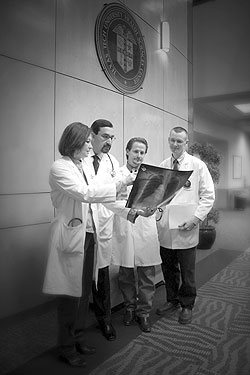Research/Academic Showcase
Texas Tech University
Link Between ADHD, Television Viewing Habits among Children Disputed
Trump's 'Apprentice' Benefits Mentor Tech Program
Texas Tech University Health Sciences Center
Task Force Addresses Consequences of Texas' Uninsured
STAR Brings New Hope for Women in Preventing Invasive Breast Cancer
Alumni Highlights
Nelnet's Loan Consolidation Program Could Save You Thousands
Development
New Law Scholarships Honor Legal Legends
Capital Campaign Focuses on Delivering New Facility for Rawls College of Business
Texas Tech's 'From Here, It's Possible' Contest Winners Announced
Athletics
Jones AT&T Stadium to Receive FieldTurf Surface for 2006 Season
Texas Tech University Press
New Book on the History and Mystery of the Collared Peccary
Helpful Links
STAR Brings New Hope for Women in Preventing Invasive Breast Cancer
 The Health Sciences Center and UMC Southwest Cancer Treatment and Research Center participate in one of the largest clinical trials ever conducted.
The Health Sciences Center and UMC Southwest Cancer Treatment and Research Center participate in one of the largest clinical trials ever conducted.
Research/Academic Showcase
Sara has lost her mother to breast cancer and has two daughters and one granddaughter who were diagnosed with breast cancer. Given her family history, Sara is at high risk for breast cancer.
 Experts from the Texas Tech University Health Sciences Center bring a multidisciplinary approach to learning more about cancer and about how to best treat patients in the UMC Southwest Cancer Treatment and Research Center.
Experts from the Texas Tech University Health Sciences Center bring a multidisciplinary approach to learning more about cancer and about how to best treat patients in the UMC Southwest Cancer Treatment and Research Center. According to the National Cancer Institute, in the United States, breast cancer is the most common non-skin cancer and the second leading cause of cancer-related death in women.
Experts from the Health Sciences Center and the UMC Southwest Cancer Treatment and Research Center participated in a clinical trial that brings hope to women like Sara. The cooperative efforts between the two centers brings a multidisciplinary approach to learning more about cancer and about how to best treat patients. Health Sciences Center team members include Cynthia Jumper, M.D., professor of internal medicine; Everardo Cobos., M.D., professor of internal medicine and medical director the the center; Robert Bright, Ph.D., associate professor of microbiology and immunology and director of basic research for the center; and Thomas Warren, M.D., assistant professor of surgery.
In the Study of Tamoxifen and Raloxifene, or STAR, 19,747 postmenopausal women who were at increased risk of the disease enrolled. Results of the trials show that both drugs reduced the risk of developing invasive breast cancer by about 50 percent.
The women involved in the study were followed for an average of four years. Those assigned raloxifene had 36 percent fewer uterine cancers and 29 percent fewer blood clots than the women who were assigned to take tamoxifen. Uterine cancers, especially endometrial cancers, are a rare but serious side effect of tamoxifen. Both tamoxifen and raloxifene are known to increase a woman’s risk of blood clots.
The trial is coordinated by the National Surgical Adjuvant Breast and Bowel Project, a network of cancer research professionals, and is sponsored by the National Cancer Institute, part of the National Institutes of Health.
Everardo Cobos, M.D., Texas Tech University Health Sciences Center professor and director for the Southwest Cancer and Research Center served as the primary investigator for the study. He says in 1998, the landmark Breast Cancer Prevention Trial showed that tamoxifen could reduce the risk of invasive breast cancer in premenopausal and postmenopausal women by nearly 50 percent.
 Dr. Everardo Cobos, HSC professor and director for the Southwest Cancer and Research Center, served as the primary investigator for the study.
Dr. Everardo Cobos, HSC professor and director for the Southwest Cancer and Research Center, served as the primary investigator for the study. “Today, we can tell you that for postmenopausal women at increased risk of breast cancer, raloxifene is just as effective, without some of the serious side effects known to occur with tamoxifen,” Cobos says.
Women taking either drug had equivalent numbers of strokes, heart attacks, and bone fractures. Both raloxifene and tamoxifen are known to protect bone health; estimates show that a half million postmenopausal women are currently taking raloxifene by prescription to prevent or treat osteoporosis. Additionally, the initial results from STAR suggest that raloxifene does not increase the risk of developing a cataract, as tamoxifen does.
“Although no drugs are without side effects, tamoxifen and raloxifene are vital options for women who are at increased risk of breast cancer and want to take action,” Cobos says. “For many women, raloxifene’s benefits will outweigh its risks in a way that tamoxifen’s benefits do not.”
The STAR researchers also tracked known menopausal side effects that occur with both drugs and monitored the participants’ quality of life. The data show that side effects of both drugs were mild to moderate in severity, and quality of life was the same for both drugs.
Women who participated in STAR were postmenopausal, at least 35 years old, and had an increased risk of breast cancer as determined by their age, family history of breast cancer, personal medical history, age at first menstrual period and age at first live birth.
For Sara the numbers all have faces. “By the time that my granddaughter becomes a woman, I hope that she does not even know breast cancer and that it is something of the past. The benefits from this study would be outstanding.”
Related Links
For tools used to calculate a woman’s risk of breast cancer, visit http://cancer.gov/bcrisktool or http://breastcancerprevention.com.
Read about more Health Sciences Center research at www.hsc.edu.